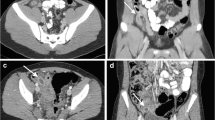Abstract
We compared the effect of low-density barium sulfate neutral oral contrast agent on the diameter of normal appendix and its luminal content versus that of water on multidetector-row CT. CT scans of 24 patients who had been imaged on two separate occasions for the evaluation of pancreatic pathology, once with water and subsequently with low-density barium sulfate as the neutral oral contrast agent were evaluated (total of 48 scans). Studies were randomized and reviewed in consensus on a workstation in the stack mode by two radiologists blinded to the type of oral contrast. The appendix was measured at baseline and 10 days later to obtain an average diameter. Results of the water and low-density barium sulfate groups were compared using paired t test. Contents of the appendiceal lumen were also noted (gas, fluid, mixed, and collapsed appendix). The average diameter of the appendix for scans obtained with water and low-density barium sulfate was 4.09 ± 0.87 mm (median, 4.22 mm; range, 2.50–5.65 mm) and 4.13 ± 0.93 mm (median, 4 mm, range, 2.2–5.65 mm), respectively. This difference was not statistically significant (P = 0.69). There was no statistically significant difference in the appendiceal content when water or low-density barium sulfate were used as oral contrast (χ 2 = 4.25, P = 0.89). Low-density barium sulfate does not affect appendiceal content or diameter and, therefore, should not adversely affect evaluation of the appendix on multidetector row CT.


Similar content being viewed by others
References
Megibow AJ, Babb JS, Hecht EM et al (2006) Evaluation of bowel distention and bowel wall appearance by using neutral oral contrast agent for multi-detector row CT. Radiology 238:87–95
Winter TC, Ager JD, Nghiem HV, Hill RS, Harrison SD, Freeny PC (1996) Upper gastrointestinal tract and abdomen: water as an orally administered contrast agent for helical CT. Radiology 201:365–370
Minordi LM, Vecchioli A, Mirk P, Filigrana E, Poloni G, Bonomo L (2007) Multidetector CT in small-bowel neoplasms. Radiol Med 112:1013–1025
Horton KM, Eng J, Fishman EK (2000) Normal enhancement of the small bowel: evaluation with spiral CT. J Comput Assist Tomogr 24:67–71
Paulsen SR, Huprich JE, Fletcher JG et al (2006) enterography as a diagnostic tool in evaluating small bowel disorders: review of clinical experience with over 700 cases. Radiographics 26:641–657, discussion 657–662
Huprich JE, Fletcher JG, Alexander JA, Fidler JL, Burton SS, McCullough CH (2008) Obscure gastrointestinal bleeding: evaluation with 64-section multiphase CT enterography–initial experience. Radiology 246:562–571
Tochetto S, Yaghmai V (2009) CT enterography: concept, technique, and interpretation. Radiol Clin North Am 47:117–132
Blake MA, Setty BN, Cronin CG et al (2009) Evaluation of the effects of oral water and low-density barium sulphate suspension on bowel appearance on FDG-PET/CT. Eur Radiol 20:157–164
Kim HC, Yang DM, Jin W, Park SJ (2008) Added diagnostic value of multiplanar reformation of multidetector CT data in patients with suspected appendicitis. Radiographics 28:393–405, discussion 405-396
Gore RM, Balthazar EJ, Ghahremani GG, Miller FH (1996) CT features of ulcerative colitis and Crohn's disease. AJR Am J Roentgenol 167:3–15
Raptopoulos V, Davis MA, Davidoff A et al (1987) Fat-density oral contrast agent for abdominal CT. Radiology 164:653–656
Gossios KJ, Tsianos EV, Demou LL et al (1991) Use of water or air as oral contrast media for computed tomographic study of the gastric wall: comparison of the two techniques. Gastrointest Radiol 16:293–297
Megibow AJ, Zerhouni EA, Hulnick DH, Beranbaum ER, Balthazar EJ (1984) Air insufflation of the colon as an adjunct to computed tomography of the pelvis. J Comput Assist Tomogr 8:797–800
Young BM, Fletcher JG, Booya F et al (2008) Head-to-head comparison of oral contrast agents for cross-sectional enterography: small bowel distention, timing, and side effects. J Comput Assist Tomogr 32:32–38
Rollandi GA, Curone PF, Biscaldi E et al (1999) Spiral CT of the abdomen after distention of small bowel loops with transparent enema in patients with Crohn's disease. Abdom Imaging 24:544–549
Conflict of interest
None
Financial disclosure
None
Author information
Authors and Affiliations
Corresponding author
Rights and permissions
About this article
Cite this article
Yaghmai, V., Aghaei-Lasboo, A., Brandwein, W.M. et al. MDCT appearance of the appendix: how does the low-density barium sulfate oral contrast agent affect it?. Emerg Radiol 18, 11–15 (2011). https://doi.org/10.1007/s10140-010-0894-7
Received:
Accepted:
Published:
Issue Date:
DOI: https://doi.org/10.1007/s10140-010-0894-7




